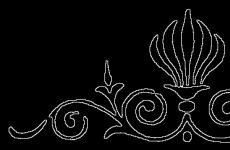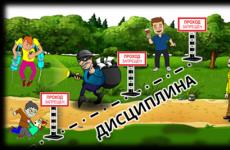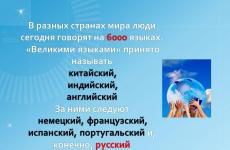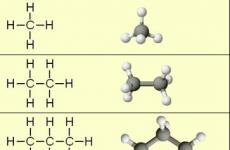Metal lightweight designs. Lightweight metal structures Strengthening reinforced concrete structures
Publisher: "Budivier"
The year of publishing: 1978
Language: Russian
Pages: 112
Introduction
Chapter 1. Bent profiles - the new kind highly economical metal rolling for construction
The struggle for reducing the mass of metal structures, for increasing their strength, reliability and durability led to the creation of a new type of rental - bent profiles. Bent profiles are various configurations corrugated sheets: tiny, trough, closed and other section parts of almost unlimited length and constant thickness In all elements on cross section.
There are several ways to get bent profilesNamely: stamping, bending on the press and broach. However, the use of these methods of manufacturing bent profiles does not allow to receive profiles long length, widths and thickness. In addition, these methods are low-performance, lead to large losses Metal, process of receiving profiles with a complex configuration cross section The narrow range along the length, width and thickness of the initial blanks and the high cost of bent profiles obtained by stamping, flexible on the press or broach, dramatically limit the scope of their use, is very difficult.
Eliminate the listed shortcomings of bent profiles became possible in the manufacture of them on a fundamentally new method and on constructive new equipment. Such equipment turned out to be similar rental special profilegile units. Bottled profiles obtained on these mills are called bent rolled profiles. In principle, from the point of view of manufacturing technologies, the differences between the curved profiles of rolled products from hot rolled is to obtain them from the initial billet in the cold state and the immutability of the cross-sectional area during the forming process. Equipment for the manufacture of curved ride profiles is less difficult than rolling or presses, its manufacture is cheaper, and the maintenance is easier and easier. Investments and operating costs in organizing the production of bent rolled profiles are significantly less than with other types of metal processing, and initial costs pay off in a short time.
Both rolled profiles are manufactured by the method of continuous profiling of sheets, lanes from tapes on profilegibilic units different types. The process of profiling consists in a consistent change in the cross section of the initial billet (stripes, flippers, tapes) when it passes through a row of rotating horizontal and vertical (idle) rolls (rollers) towards each other.
Chapter 2. Metal lightweight structures from closed bent profiles
Especially promising is the use of curved profiles in lightweight frameworks
The main advantage of benut-car closed profiles (GSP) compared to others, the following is:
1) the economy of characteristics by mass flowing into a favorable distribution of material in cross sections of structural elements with a decrease in structural coefficients as a result of a decrease in the volume of auxiliary n connective parts;
2) The possibility of using a sheet of small thicknesses (2-3 mm compared to 5-6 mm in constructs from ordinary profiles) due to increased corrosion resistance and local stability. The same abilities make it possible to effectively apply high strength to HSPs;
3) reduced vulnerability of elements of structures from closed profiles during transportation and installation due to the absence of protruding edges;
4) improvement performance Due to the increased corrosion resistance and the reduced outer stained surface of the structures, etc.
Technical and economic studies show that GSPs are very effective in stem systems and practically give the same indicators by weight as the pipes.
In the works of the Institute, UKRPSK proposes the creation of low-element farms, in order to simplify the nodes and reduce the structural coefficients.
In the lungs low-loaded structures, along with closed bent-armed profiles, it is advisable to apply both open bent profiles. So, B. stropyl farms A span of 12-18 m under light roofs and in other lattice structures that perceive relatively small loads, the use of open bent profiles gives metal savings to 20-30%. With an increase in the span, the effectiveness of the application open profiles Over the flights of more than 24 m of substantial metal savings, it cannot be achieved in this case, the savings can not be achieved only when applying closed bent-armed profiles.
As experience has shown, successful solutions schemes, designs, nodes selected forms of sections, welding technology, etc. allow you to create truly progressive building metal structures for medium and heavy loads, in many cases successfully competing with tubular, and sometimes superior to them.
However, for widespread introduction, it is necessary first of all to develop a single point of view regarding the whole problem, unfortunately, not all organizations share the opinion on the feasibility of widespread use of bent profiles. Much attention paid to the pipes, disbelief in the effectiveness of the use of bent profiles, in some cases the negative impact of planning on tonnage to a one-way approach to assessing the coefficient of specific labor intensity of the factory production of structures is largely hampered by the development of an important direction of metal-building.
Chapter 3. Bent corrugated profiles in metal structures
In metal lightweight structures, various corrugated bent profiles are widely used as ready parts that accelerate installation improve appearance, reduce construction deadlines and reduce it. These profiles may have corrugations of various shapes: semicircular, straight, trapezoidal "triangular with a dull vertex and others. A wide range of corrugated sheets applied to the last time, was a consequence of the consumers made them for their own needs on existing equipment. In the absence of any unification for the production of profiles, differing among themselves, the form of corrugations was necessary a large number of Profile rolls or stamps, for the manufacture of which was spent a lot of time and high-quality steel.
To reduce the number of profile-sizes of reducing costs for their development, acceleration of production and consumers, unification and standardization of corrugated profiles were carried out. Two standards have been developed on corrugated curved rental profiles GOST 9234-73 and GOST 10551-75, which cover all profiles currently produced for various industries. In order to reduce the number of profiles manufactured from galvanized workpiece, the unification of their size is developed by the standard for leaf galvanized corrugated steel used, mainly in construction.
When developing standards, materials were used on the needs of the national economy in corrugated profiles, the sorting of profiles used in the construction and industry and the sorting of corrugated profiles, developed by the metallurgical and engineering plants. It should be noted that in last years Not only the sortment has significantly expanded, but also has grown the need for corrugated bent profiles.
Chapter 4. Perforated bent profiles in metal structures
Recently in our country and abroad in various industries and construction, curved perforated rental profiles are becoming increasingly distributed.
The use of such profiles in various branches of the economy allows to reduce metal consumption by 18-20%, accelerate the assembly and installation of structures, eliminate welding work When installing, reduce labor intensity mounting work. The assembly of metal structures from perforated profiles is a modern and rational construction system.
The bent perforated includes profiles in which there are different shapes of the sizes of the opening, applied along the entire length with a certain step (module) of perforations.
Perforated profiles, depending on their application, should be divided into two large groups: profiles for collection and collapsible structures and special-purpose profiles.
The first group includes perforated corner and chamber-secting profiles, whose bolted compound in various combinations allows to obtain lightweight metal structures of all kinds of species and appointments.
The most important advantages of perforated profiles of this group are their ease, the possibility of quick installation without welding, the multipleness of using the same profiles in the collapsible structures various destination other. These profiles, which are universal building material, are called profiles for quick assembly.
The second group includes special-shaped profiles that have applications only in certain designs. Perforated profiles are the basis complex system Codestructive elements for the manufacture of all kinds of metal structures in construction, warehouse, transport and manufacturing equipment.
Chapter 5. Lightweight panel spans and fencing structures from bent profiles
Construction is one of the main consumers of curved rental profiles. The use of such profiles allows to obtain the most advanced solutions of elements of buildings both by architectural and aesthetic and technical and economic indicators. Work is underway to further improve the designs of the panel binding of industrial and administrative buildings in order to facilitate the designs of the bindings, improving labor productivity in their manufacture, improving the working conditions inside the premises by increasing the light, improving the architecture of buildings in the industrial and civil construction of CCHSR is widely used, bent profiles Various configurations with a thickness of up to 2 mm: open, semi-shined, closed with double thickness elements and a large amount of bendes.
When developing a sorting of profiles for panel binding, they took into account their manufacturing technology on existing profilegile units, as well as the technology of manufacturing the binding at the metal structures factories to speed up the assembly of structures, reduce their cost and provide a good appearance.
Compound open types Bottled profiles in closed metal structures are most acceptable method of electrical arc welding. However, this welding method is low-performance.
Architectural and structural elements from profile lightweight rolled products are widely used in modern construction in the form of metal window and showcase bakes, glass metal doors, staircases and balconies, door boxesguides for sliding doors and partitions.
The sorting includes profiles open, semi-jamped and closed cross-sectional shape, as well as with double thickness elements. Separate profiles perforated.
Applications
Literature
- 688 views
Metal structures Currently gained very widespread. If they were previously used in construction only industrial enterprisesnow these are building construction Strengthened positions in the construction of new residential buildings and structures.
Today, there is already an acute issue of relief (reduction of mass) of metal structures. Moving in this direction, designers reduce the metal of the building and "kill" two "hares" at once:
- the cost of the construction under construction is reduced;
- the mass of the building is reduced. This leads to a decrease in the volume of the foundation and, ultimately, again to the budget economy of the whole construction.
Building construction framework technology
Everywhere the framework of buildings and structures under construction frame technologyManufactured from cold-made profiles (σ-shaped or s-shaped) and (or) cooked with each other of alternating and constant sections.
The fences are made of leaf (lung) metal, which, to give it hardness, is exposed to strain:
- profiled sheet;
- profiled sheet with foil mineral wool insulation;
- sandwich panels, etc.
This is described in detail in the article "Design of metal structures" and on our website.
Thus, buildings and structures built on frame technology have a small mass. In addition, they have a number of undeniable advantages:
- they are possible (thanks to the component products on a specialized enterprise and the creation of a foundation on a construction site) to build in a short time;
- they have high maintainability. If any part or node failed, they are possible relatively easy to dismantle (it is not necessary to disassemble the whole house - it is only necessary, as in any mechanism, "develop" threaded connection replaceable node) and replace exactly the same factory manufacture;
- to build a building on such technology, a very modest budget is required and more.
Today we will talk about other ways to give hardness sheet metal.which is used in the production of metal structures.
Ways to give stiffness to sheet metal
One of the new, but already popular methods was the creation of lightweight metal structures. The new competitive technology in construction, which has such a name, is to apply a wide variety of progressive spatial forms during metal deformation:
- bulk faces;
- geometric figures:
- rectangular deepeners
- rounded trays, etc.
Such an appearance is achieved by the method of cold bending (cold deformation) of special blanks. So that the metal elements have mechanical stiffness, and the nodes are high strength, connect their vertices.
As a result, the connection is created by a binding forming a rigid rod system. It should be borne in mind that the harder the form, the higher the strength and carrying capacity of the metal structural collection.
From metal products that have such a design, you can collect:
- frameless construction objects;
- the basis for plating walls, facades, etc.
There are several special design techniques aimed at increasing mechanical strength Each separate part.
Ways to increase the mechanical strength of lightweight metal structures
There are several structural techniques (laid in the design structure at the stage of its development) intended to increase the mechanical stiffness and strength of lightweight metal structures:
- the longitudinal profiling is carried out. It lies in the creation of horizontal surface sections in the direction of steel sheet rolled;
- corrugated faces. Corrugations are created, the ribs of which prevent the deformations of the part during operation;
- footman. The method of stamping is created a variety of volumetric bubbles (convex or recessed), cutting ribs of stiffness and so on.
Lungs steel structures - this is new coil Development in industrial construction. Buildings from light steel thin-walled structures are strong and reliable, to build them by 25-40% more profitable than ordinary traditional structures, and constructive feature Allows you to implement complex and original projects.
Light steel structures
There are two types of metal structures:
- LSTK - Light steel thin-walled structures
- LMK - Light Metal Structures

LSTK is a lightweight version of a metal building, thickness steel profile is 0.2-0.4 mm, while building a warehouse and industrial premiseswhich will be seismically stable and durable.

LMK is metal buildings with a metal used with a thickness of up to 4 centimeters. These are durable and reliable structures that build for different areas of human vital activity.

Prices for light steel structures today differ and depend on the construction region. In the central regions Russian Federation Construction of steel buildings is cheaper, due to the high concentration of manufacturers, the availability of competition and, accordingly, more favorable offers. The average cost of one ton of metal structures is 50,000 - 79,000 rubles.

An interesting feature You can call a simple commissioning of the object. As LSTK and LMK design They are not traditional, that is, capital structures from stone and concrete, the process of registration and commissioning occurs in a simplified mode, without paper red tape.

Light steel thin-walled structures: technology
LSTK is more popular in Russia, as the technology implies simple and fast mounting steel carcasswho are able to implement themselves on their own hands.

Technology emerged in 1950 in Canada. Availability building material And the low cost of building buildings quickly popularized thin-walled structures in Japan, Scandinavia and North America.

Stages of building a quick-scale building:
- Design.
- Preparation of the foundation (any small blowjob).
- Order metal frame.
- Installation.
- Entering a building commissioning.

Advantages of LSTK:
- Low cost.
- Easy assembly.
- Durability and wear resistance.
- Quick installation.
- Independence OT climatic conditions, the ability to build in cold and wet weather.
- Seismic stability design.
- Good properties of heat saving.
- Lack of shrinkage on the foundation.

What are the LSTK?
Lxtk buildings are built from profiles that produce from high strength galvanized steel. The entire production cycle is automated, in the presence of project documentation, a metal rolling plant will prepare each detail of the future building with the necessary holes and marking.

The construction of the LSTK is not costly, since from the zero stage you can save well on the foundation device and in the final stage on insulation. LSTK is suitable for the construction of a residential building, cottage, greenhouses, hangars and many other facilities.

Video
Production of metal structures carried out at your own factoryLocated in MO, Noginsky District, Old Kupavna, a member of the group of companies "Stellastroy", according to customers, the drawings, or by project documentation developed by the project department of the company.
The plant is equipped with all the necessary high-tech equipment, it has in its composition, equipped with certified equipment.
Our services for the production of metal structures:
- Cutting sheet: plasma cutting
- Cutting sheet: Hubbling guillotine
- Design of metal structures
- Installation of metal structures
- Dismantling of metal structures
- Painting Metal structures
- Delivery of metal structures
Metal structural production consists of several stages:
Check the quality of metal rolling;
Production of metal structures begins with the quality control of metal products and includes a list of various checks. Initially, the accompanying documents (certificates and overhead), packaging condition and labeling are being studied. Then the geometrical characteristics and condition of the surface (flexibility, the presence of cavities, cracks and other deformations) are checked. Next are conducted chemical composition and mechanical strength.
Metal processing, giving shape (grinding, bending, cutting, etc.);
Production of metal structures is associated with metal processing, which is carried out by specialists using modern technologies. Technology is a variety of processes. This includes bending (manufacturing profiles, corners with listogibochny machine); polishing and grinding (giving friction or gloss, elimination of irregularities); cutting (laser and semi-automatic); Cutting (transverse and longitudinal separation using guillotine machine).
Processing of metallic blanks with special compositions;
Applying an anti-corrosion and other protective coating on metal structures;
Metal products have increased sensitivity before negative impacts Environments: humidity, temperature, etc. Increase the stability of structures helps processing with special compositions. We recommend ordering popular zinc compositions preventing corrosion as well fire retardant coatingsSlowing ignition processes.
Welding, bolted or rivet - assembly of structures in modules;
When installing metal structures, it is necessary to connect to the frame, consolidating them suitable way: Bolts, rivets or welding. Bolt connections Connectors are easy to perform and can be carried out without special equipment. There are welding that applies most often. Severe structures with large loads involve the use of rivets.
Painting ready-made details.
The production of metal structures is completed by painting parts. The most advanced method for today is powder. Before the painting is degreasing and cleared. Then the pulverizer is applied a tightly adjacent powder. After that, the details are heated in the chamber, and under the influence of temperature, the coating reliably hardens. This method is distinguished by durability, efficiency, aesthetic species.
During the work, the company "Stellastroy" lined up close relationship with metal suppliers - metallurgical combine, which allows to provide partners raw materials and services at the minimum price. Metal structures produced are shipped from the warehouse, or on their own transport delivered to anywhere in Moscow and Moscow region.
Strengthening designs It is necessary in the case when the building load began to exceed the maximum allowed, incorporated in the project. This can be a consequence of work on the construction of additional floors, or errors in an unscrupulous design, violation of the rules of operation, a change in the functionality of the building, corrosion processes.
But most often the strengthening of the island or parts of the structure becomes necessary due to its wear.
Strengthening building building
Strengthening the structure of the building involves carrying out work aimed at maintaining the ability of the building to make heavy loads and enhancing its hardness. Procedures for strengthening structures are related to the use of various methods.
The main ones are gaining carrier ability, restoration of the construction of the building, its unloading, as well as amplification individual elements. Depending on the material distinguish:
- gain metal structures,
- strengthening reinforced concrete structures,
- gain wooden structures etc.
We will reflue some of them.

Strengthening reinforced concrete structures.
To enhance the reinforced concrete structures, work with the foundation, elements of overlapping, beyls, columns. As for farms and beams, they are usually replaced.
Strengthening procedures preceded by the preparatory work stage. For the creation of additional supporting conditions, the load of the carrier parts is distributed more evenly and is transmitted to new elements. It is important to understand that the strengthening of the building is associated with risk, as it is impossible to accurately assess the initial data of old structures.

Strengthening metal structures
To enhance metal structures, or increase the area of \u200b\u200bthe cross section, which is loaded, or increase its rigidity. Before the start of all procedures, it is necessary to familiarize themselves with the project documentation and the materials for the operation of the building. Further, evaluation procedures and home research are carried out.

The company "Metal structures of MSC" has significant experience in strengthening metal and other types of building designs. We offer weighted solutions and use modern methods and materials that will allow your building to last for many years!
Order Strengthening structures
"Metal structures of MSC" will be engaged in the strengthening of structures various meanings. Works on the strengthening of metal structures and various buildings begin in 24 hours After signing the contract. Always ready for the exit brigade Installers.
Payment
Metal manufacturing payment is made in two ways:
- in cash;
- cashless translation.
Cash You can pay the entire amount immediately or divided into 2 parts - prepayment and residues. Cash payment occurs after the conclusion of a service provision agreement.
Cashless translation It implies the transfer of funds. Translation can be made from a current account on account or from a bank card to the account. For customers, the amount with VAT is possible and without VAT.
The payment process must be negotiated at the conclusion of the contract.
The team of masters "Metal structures of MSC" will make all the work in the agreed time and in the best way.






